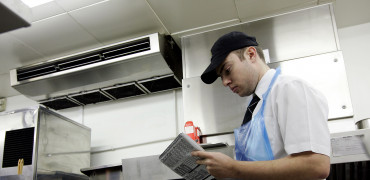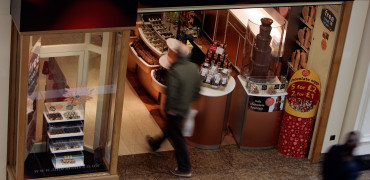I have no connection to the restaurant industry, but as a regular restaurant eater, I believe I’ve built up enough experience to give my thoughts on what makes a comfortable restaurant experience. From greasy spoon to Michelin star I’ve eaten in a vast selection of eateries showcasing a variety of cuisine from around the world – but not every experience has been an enjoyable one!
When it comes to restaurants, it’s not just about taste (although to receive a Michelin star, it’s all about the food!); its smell, sight, sound and touch too, and after speaking with a variety of my fellow restaurant goer colleagues, we have put together a list of the top requirements that make a top restaurant, whether you’re a restaurant owner or just a regular customer.
The Seating Plan
The seating plan of a restaurant not only sets the scene but also defines the practicality and the privacy of a restaurant experience. It has to make sense to both the diners and the staff because there nothing worse than a bumped chair while you’re slurping your soup, or an obstacle course on your way to the toilet.
For waiting staff, a complicated or compact seating plan could cause issues such as confusion when knowing which tables they are looking after. Also in restaurants where food is delivered on large trays with table stands, a lack of space could lead to accidents which could ultimately have detrimental effects for restaurants businesses. After all, good waiting service is a huge part of the customer service which can lead to positive reviews and repeat custom.
Talking about reviews, one of the most common complaints from restaurant goers is draughts due to poor location of tables near doorways, windows and kitchens, so it’s best to avoid that if possible. Another common complaint is low ceilings, low lighting fixtures and low shelving which are all hazards to the head when close to seating locations.
For many restaurant owners and managers, the seating plan of the restaurant actually requires a lot of thought, as noted by the operations manager at Gidleigh Park, a Michelin star restaurant in Devon who explains on Elite Traveller that they try not to put small tables near large tables as the space would look over powered. So if you are in the restaurant industry, it’s worth doing some research and putting some time into working out these elements to see if it will make a difference to your space and service.
The Restaurant Temperature
Temperature discomfort in restaurants is one of the biggest reasons that a customer’s experience might be compromised and usually it’s an easy issue to solve. A well cooled and ventilated kitchen will allow hot air to escape (and with the right technology this can be recovered for use elsewhere such as heating the water for the kitchen) and temperatures to be regulated; a key necessity for kitchen staff, as explained by my colleague Luke here.
A good quality heating and cooling system that matches the capacity of the restaurant requirements will also help balance temperatures. If the restaurant you work in is big enough you can even zone the indoor air conditioning units so that by the door the temperature can be raised a few degrees on a cold day and by the kitchen temperatures can be lowered during peak hours. Some indoor units even have sensors that can adjust airflow and direction based on the temperature of individual diners, allowing the climate to be controlled automatically.
Another solution which is suitable for many restaurant environments is an air curtain which fits over the front door and regulates the incoming air. These systems are very popular in retail properties, allowing an open door policy without compromising the indoor air temperature. This is ideal for energy efficiency and cost savings, especially if restaurant owners/managers utilise a heat pump air curtain (which is a lot more efficient than a direct electric unit).
The Chairs and Tables
The right size of table and chairs can make a big difference to a comfortable dining experience, especially when a customer walks into a restaurant and doesn’t expect the only options to include bar stools or lounge chairs. Standard dining height is 750mm for a table and 470mm for a chair, anything higher or below that is based as bar height, which creates a causal environment, so always make sure your customer knows what to expect.
Of course the size of tables and chairs should also be based on how many diners can comfortably fit into a restaurant space. Typically each diner will require at least 600mm in width with at least one person’s width between them. This can be increased and decreased depending on the style of the restaurant. In terms of space between tables it has been suggested that tables should have around 700-800mm of space between them, allowing for diners to comfortably walk without nudging chairs, creating a fluid restaurant flow.
The Visual Impact
In an Instagram ruled world, the way your restaurant looks is becoming one of the major pull strategies to attracting diners. Recently cafes like Peggy Porschens and Elan Cafe are filling the feeds of social media due to their attractive designs which typically include a vast array of flowers. But while this isn’t appropriate for 99% of restaurants, having a visual impact, personality and ambience is.
Having a visual element to a restaurant should also go beyond the interior, in fact many people now admit that they choose their food options based on how it looks (another symptom of Instagram now doubt) so having attractive dishes shouldn’t go a miss. A great way to show off the presentation of food is tapping into the Instagram culture by having a restaurant account (something I always search for when going to a new place), then if there isn’t visual menu (I suggest restaurants include a QR code on menus) customers can see just how their choices will look.
Talking about menus, if you’ve ever been a fan of Gordon Ramsey’s Kitchen Nightmares, one of the most common mistakes that restaurants make which aids in driving business away, is having a complicated and large menu. A short, concise and well-presented menu makes things easier for staff and easier for us diners.
For more information on menu tricks, have a look at this article on The Guardian.
The Ambience
I mentioned ambience in the previous paragraph but it deserves a lot more attention than just one sentence. Ambience is what can set a restaurant apart from another and keep customers returning for years to come. Charismatic staff, calming music – or music that matches the environment (think Nandos and their Portuguese tunes) and a nice smell all provide a well-rounded feeling. Great ambience also means diners won’t be in a rush to head off when the food has been eaten which is likely to increase the bar bill!
Other important elements relating to ambience are lighting, décor and colour and these should all reflect the brand that the restaurant is representing. Some of my and my colleague’s favourite restaurants in terms of ambience include:
- Sketch (suggested by me) – A restaurant in London which has ambience down to a tee. With a variety of different themed rooms, the interior, the staff, the food and even the toilets represent a Wes Anderson style dreamland.
- The Ham Yard (suggested by my colleague Sharon) – This restaurant and bar is part of the Ham Yard Hotel, also in London. It not only has a wonderful and sophisticated ambience but also uses the finest seasonal ingredients, and has pretty good cocktails too!
- Midsummer House (suggested by my colleague Russell) – This Michelin star restaurant is located in Cambridge and is an extremely fine dining experience with impeccable service levels and an ambience to match.
- Vertigo and Moon Bar (suggested by my colleague Martin) – This alfresco masterpiece is located 61 storeys high on top of the Banyan Tree hotel in Bangkok. Best enjoyed at night, the lighting is low, the food is premium and the view is jaw dropping.
- Mabruk Mediterranean (suggested by my colleague Janvi) – This casual, low seating restaurant is located in the Sahara Star hotel in Mumbai. The seating is widely spaced as the restaurant fills a very large space in the centre dome of the hotel. The visual impact of the restaurant includes palm trees and lagoon with a ‘real life’ mermaid!



